
Fractal art is a form of algorithmic art created by calculating fractal objects and representing the calculation results as still digital images, animations, and media. Fractal art developed from the mid-1980s onwards. It is a genre of computer art and digital art which are part of new media art. The mathematical beauty of fractals lies at the intersection of generative art and computer art. They combine to produce a type of abstract art.

A fractal landscape or fractal surface is generated using a stochastic algorithm designed to produce fractal behavior that mimics the appearance of natural terrain. In other words, the surface resulting from the procedure is not a deterministic, but rather a random surface that exhibits fractal behavior.

In computing, a hardware random number generator (HRNG) or true random number generator (TRNG) is a device that generates random numbers from a physical process, rather than by means of an algorithm. Such devices are often based on microscopic phenomena that generate low-level, statistically random "noise" signals, such as thermal noise, the photoelectric effect, involving a beam splitter, and other quantum phenomena. These stochastic processes are, in theory, completely unpredictable for as long as an equation governing such phenomena is unknown or uncomputable. This is in contrast to the paradigm of pseudo-random number generation commonly implemented in computer programs.

In 3D computer graphics, a voxel represents a value on a regular grid in three-dimensional space. As with pixels in a 2D bitmap, voxels themselves do not typically have their position explicitly encoded with their values. Instead, rendering systems infer the position of a voxel based upon its position relative to other voxels.

Perlin noise is a type of gradient noise developed by Ken Perlin in 1983. It has many uses, including but not limited to: procedurally generating terrain, applying pseudo-random changes to a variable, and assisting in the creation of image textures. It is most commonly implemented in two, three, or four dimensions, but can be defined for any number of dimensions.
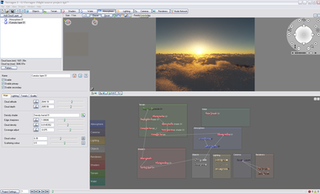
Terragen is a scenery generator program for Microsoft Windows and Mac OS X developed and published by Planetside Software. It can be used to create renderings and animations of landscapes.

In computing, procedural generation is a method of creating data algorithmically as opposed to manually, typically through a combination of human-generated assets and algorithms coupled with computer-generated randomness and processing power. In computer graphics, it is commonly used to create textures and 3D models. In video games, it is used to automatically create large amounts of content in a game. Depending on the implementation, advantages of procedural generation can include smaller file sizes, larger amounts of content, and randomness for less predictable gameplay. Procedural generation is a branch of media synthesis.
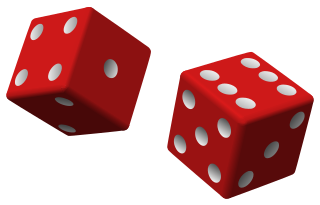
Random number generation is a process by which, often by means of a random number generator (RNG), a sequence of numbers or symbols that cannot be reasonably predicted better than by random chance is generated. This means that the particular outcome sequence will contain some patterns detectable in hindsight but unpredictable to foresight. True random number generators can be hardware random-number generators (HRNGs), wherein each generation is a function of the current value of a physical environment's attribute that is constantly changing in a manner that is practically impossible to model. This would be in contrast to so-called "random number generations" done by pseudorandom number generators (PRNGs), which generate numbers that only look random but are in fact pre-determined—these generations can be reproduced simply by knowing the state of the PRNG.
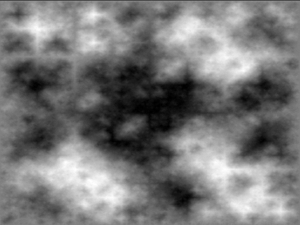
The diamond-square algorithm is a method for generating heightmaps for computer graphics. It is a slightly better algorithm than the three-dimensional implementation of the midpoint displacement algorithm, which produces two-dimensional landscapes. It is also known as the random midpoint displacement fractal, the cloud fractal or the plasma fractal, because of the plasma effect produced when applied.

In computer graphics, a heightmap or heightfield is a raster image used mainly as Discrete Global Grid in secondary elevation modeling. Each pixel stores values, such as surface elevation data, for display in 3D computer graphics. A heightmap can be used in bump mapping to calculate where this 3D data would create shadow in a material, in displacement mapping to displace the actual geometric position of points over the textured surface, or for terrain where the heightmap is converted into a 3D mesh.
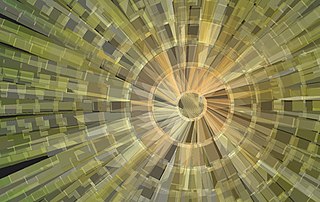
Algorithmic art or algorithm art is art, mostly visual art, in which the design is generated by an algorithm. Algorithmic artists are sometimes called algorists.

In video games, a random map is a map generated randomly by the computer, usually in strategy games. Random maps are often the core of single and multiplayer gameplay, aside from story based campaigns that are often shipped with the game. Each new game presents an unknown map, providing a new experience to the player, and an even playing field in multiplayer gaming. Random maps typically have a certain theme - for example a naval random map with many small islands, or a 'gold rush' map with a large amount of gold in the center of the map. The type of random map may also influence the game's artificial intelligence, with the AI employing different strategies optimized for each random map.
A random dungeon is a dungeon in a role-playing video game which is procedurally generated by the computer using an algorithm, such that the dungeon is laid out differently every time the player enters it, and a player often never plays through quite the same dungeon twice, as there are innumerable possibilities for how they generate.
VistaPro is 3D scenery generator for the Amiga, Macintosh, MS-DOS, and Microsoft Windows. It was written by John Hinkley as the follow-up to the initial version, Vista. The about box describes it as "a 3-D landscape generator and projector capable of accurately displaying real-world and fractal landscapes." It was published by Virtual Reality Labs and developed by Hypercube Engineering. The latest versions were published and developed by Monkey Byte Development.
Procedural modeling is an umbrella term for a number of techniques in computer graphics to create 3D models and textures from sets of rules. L-Systems, fractals, and generative modeling are procedural modeling techniques since they apply algorithms for producing scenes. The set of rules may either be embedded into the algorithm, configurable by parameters, or the set of rules is separate from the evaluation engine. The output is called procedural content, which can be used in computer games, films, be uploaded to the internet, or the user may edit the content manually. Procedural models often exhibit database amplification, meaning that large scenes can be generated from a much smaller number of rules. If the employed algorithm produces the same output every time, the output need not be stored. Often, it suffices to start the algorithm with the same random seed to achieve this.

Value noise is a type of noise commonly used as a procedural texture primitive in computer graphics. It is conceptually different from, and often confused with gradient noise, examples of which are Perlin noise and Simplex noise. This method consists of the creation of a lattice of points which are assigned random values. The noise function then returns the interpolated number based on the values of the surrounding lattice points.

Fractal-generating software is any type of graphics software that generates images of fractals. There are many fractal generating programs available, both free and commercial. Mobile apps are available to play or tinker with fractals. Some programmers create fractal software for themselves because of the novelty and because of the challenge in understanding the related mathematics. The generation of fractals has led to some very large problems for pure mathematics.
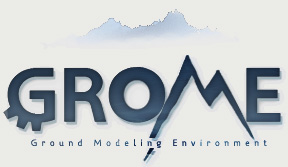
Grome is an environmental modeling package developed by Quad Software dedicated for procedural and manual generation of large virtual outdoor worlds suitable for games and other 3D real-time simulation applications.
Lateral computing is a lateral thinking approach to solving computing problems. Lateral thinking has been made popular by Edward de Bono. This thinking technique is applied to generate creative ideas and solve problems. Similarly, by applying lateral-computing techniques to a problem, it can become much easier to arrive at a computationally inexpensive, easy to implement, efficient, innovative or unconventional solution.
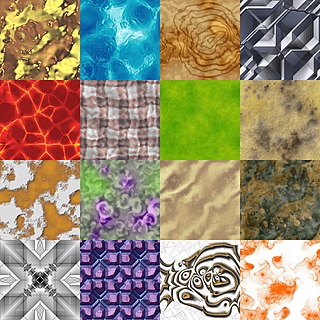
In computer graphics, a procedural texture is a texture created using a mathematical description rather than directly stored data. The advantage of this approach is low storage cost, unlimited texture resolution and easy texture mapping. These kinds of textures are often used to model surface or volumetric representations of natural elements such as wood, marble, granite, metal, stone, and others.

















